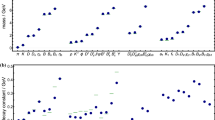Abstract
The short distance behavior of baryon-baryon potentials defined through Nambu-Bethe-Salpeter wave functions is investigated using the operator product expansion. In a previous analysis of the nucleon-nucleon case, corresponding to the SU(3) channels 27s and \( {\overline {10}_a} \), we argued that the potentials have a repulsive core. A new feature occurs for the case of baryons made up of three flavors: manifestly asymptotically attractive potentials appear in the singlet and octet channels. Attraction in the singlet channel was first indicated by quark model considerations, and recently been found in numerical lattice simulations. The latter have however not yet revealed asymptotic attraction in the octet channels; we give a speculative explanation for this apparent discrepancy.
Similar content being viewed by others
References
N. Ishii, S. Aoki and T. Hatsuda, The nuclear force from lattice QCD, Phys. Rev. Lett. 99 (2007) 022001 [nucl-th/0611096] [SPIRES].
S. Aoki, T. Hatsuda and N. Ishii, Nuclear force from Monte Carlo simulations of lattice quantum chromodynamics, Comput. Sci. Dis. 1 (2008) 015009 [arXiv:0805.2462] [SPIRES].
S. Aoki, T. Hatsuda and N. Ishii, Theoretical foundation of the nuclear force in QCD and its applications to central and tensor forces in quenched lattice QCD simulations, Prog. Theor. Phys. 123 (2010) 89 [arXiv:0909.5585] [SPIRES].
N. Ishii, S. Aoki and T. Hatsuda, Nuclear forces from quenched and NF=2+1 full lattice QCD using the PACS-CS gauge configurations, PoS(Lattice 2008)155 [arXiv:0903.5497] [SPIRES].
S. Aoki, J . Balog and P. Weisz, A pplication of the operator product expansion to the short distance behavior of nuclear potentials, JHEP 05 (2010) 008 [arXiv:1002.0977] [SPIRES].
M. Oka, K. Shimizu and K. Yazaki, The dihyperon state in the quark cluster model, Phys. Lett. B 130 (1983) 365 [SPIRES].
M. Oka, K. Shimizu and K. Yazaki, Hyperon-nucleon and hyperon-hyperon interaction in a quark model, Nucl. Phys. A 464 (1987) 700 [SPIRES].
M. Oka, K. Shimizu and K. Yazaki, Quark cluster model of baryon baryon interaction, Prog. Theor. Phys. Suppl. 137 (2000) 1 [SPIRES].
C. Itzykson and M. Nauenberg, Unitary groups: representation and decompositions, Rev. Mod. Phys. 38 (1966) 95 [SPIRES].
HAL QCD collaboration, T. Inoue, Baryon-baryon potentials in the flavor SU(3) limit from lattice QCD, PoS(LAT2009)133.
HAL QCD collaboration, T. Inoue et al., Baryon-baryon interactions in the flavor SU(3) limit from full QCD simulations on the lattice, arXiv:1007.3559 [SPIRES].
Author information
Authors and Affiliations
Corresponding author
Additional information
ArXiv ePrint: 1007.4117
Rights and permissions
About this article
Cite this article
Aoki, S., Balog, J. & Weisz, P. Operator product expansion and the short distance behavior of 3-flavor baryon potentials. J. High Energ. Phys. 2010, 83 (2010). https://doi.org/10.1007/JHEP09(2010)083
Received:
Accepted:
Published:
DOI: https://doi.org/10.1007/JHEP09(2010)083




